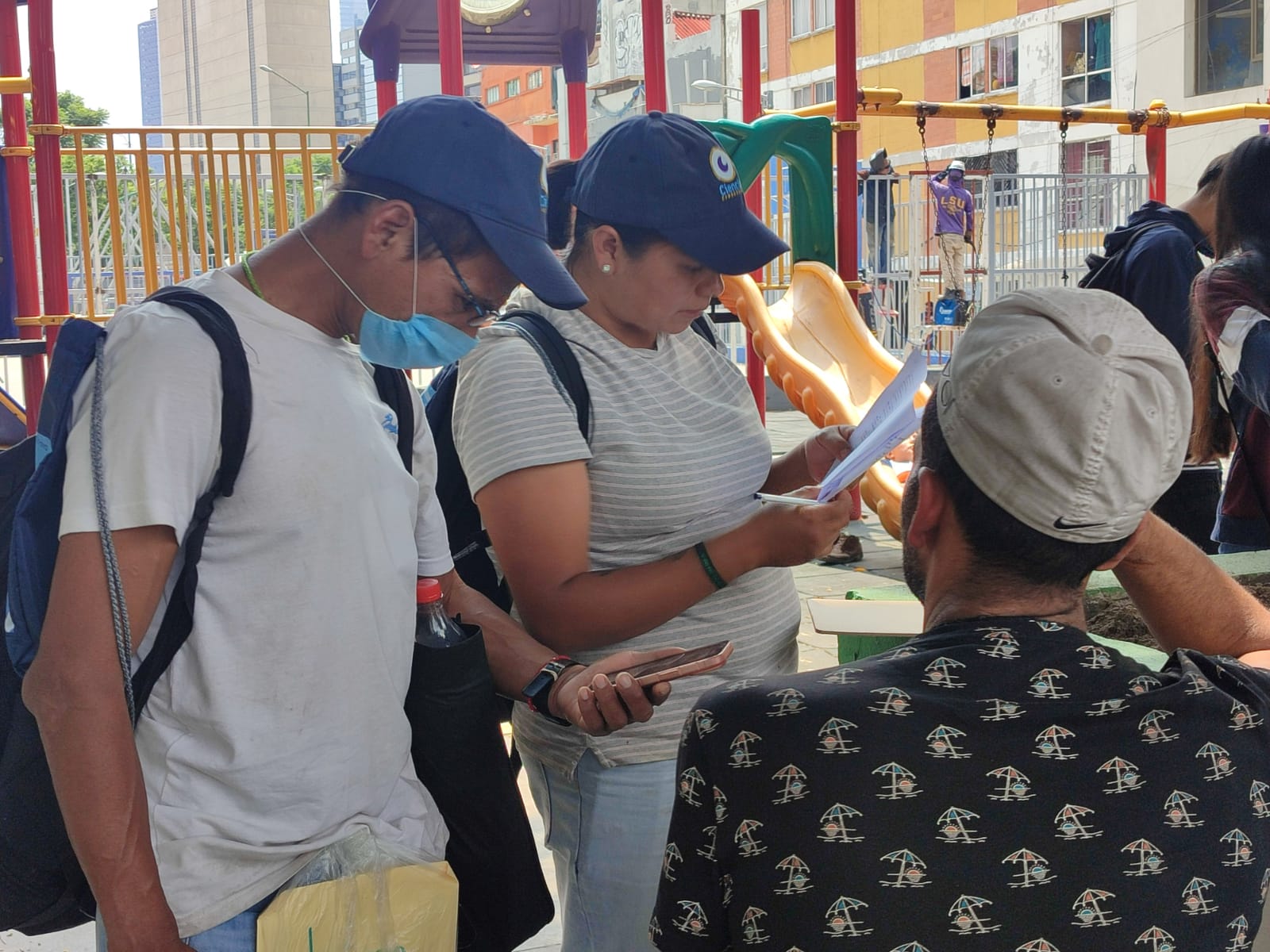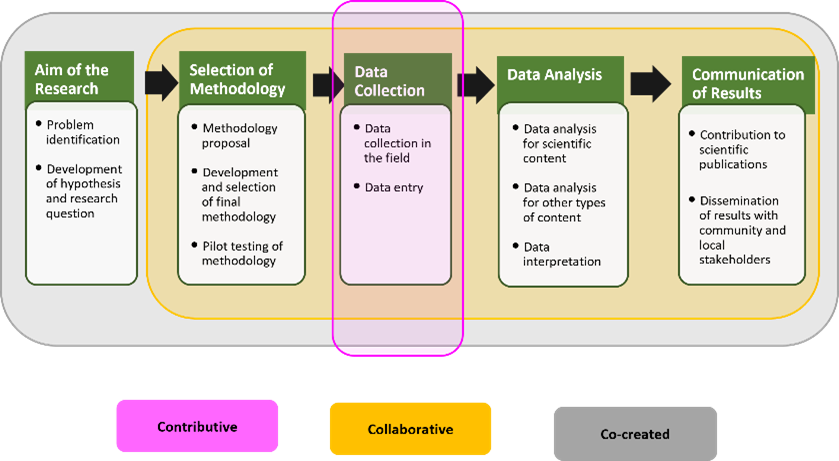Co-created Citizen Science

SEI Urban Toolbox for Liveable Cities Annotation
This tool is part of the SEI Urban Toolbox for Liveable Cities which has been developed by the SEI Initiative on City Health and Wellbeing. The Urban Toolbox is a collection of tools, developed within SEI or in coordination with SEI, aimed at supporting planning and decision-making for improving the health, well-being and resilience of city residents and urban systems more broadly.
GO TO THE SEI URBAN TOOLBOX FOR LIVEABLE CITIES HOMEPAGE
About this tool
Co-created citizen science is a methodology that enables the the partnering of scientists and members of the public to do conduct real world scientific research.
How does this tool work?
Well-designed, co-created citizen science aims to give communities a voice in projects, and empowers them to take action to tackle issues, supported by the knowledge gained through the research and projects.
Who might use this tool?
Co-created citizen science is a method that be used by researchers, start-ups, businesses, development organizations, and governments. It is recommended that the person or team leading the implementation of the methodology has a good understanding and previous experience with the research cycle.
Which stakeholders are involved?
The base of co-created citizen science is to involve citizens throughout the entire scientific research/project process. The idea is that the data collected and analyzed by the public reaches decision makers so they can make informed decisions.
What stage of the process does this tool support?
In co-created citizen science, communities actively participate in shaping research objectives, designing methodologies, analyzing data, and disseminating findings. This approach ensures research aligns with community needs and priorities while tailoring methods to suit their unique circumstances.
Additionally, it is crucial to integrate ongoing monitoring and evaluation into the project, with the design and execution of monitoring, evaluation, and learning activities collaboratively agreed upon by the group.
Tool overview
Co-created citizen science operates on the fundamental premise of active involvement by the general public (also referred to as citizens/citizen scientists) throughout the entire scientific process. Here, we outline the anticipated activities for each stage, with the understanding that these actions can be modified or extended as per the project’s duration and budget constraints.
1. Research Objective
- Problem Identification: Commencing with a workshop, citizens collaborate with researchers to identify and prioritize the most pressing community issues requiring investigation or work.
- Hypothesis and Research Questions: In this stage, citizens and researchers jointly formulate a research question that promotes their collective investigation. This question paves the way for further exploration and understanding of the issue.
2. Methodology Selection
- Exploring Methodological Options: Citizen scientists collaborate with researchers to explore potential data collection methods that can effectively address their research question. Researchers may present various alternatives for consideration by the group.
- Methodology Selection: After exploring various data collection methods, the group collectively agrees on the methodology and tools to be employed for information gathering. The choice of methodology and tools is a collaborative decision within the group.
- Creating Research Methodologies and Tools: Following the selection of data collection tools and methods, the group proceeds to develop the methodology and customize the chosen tool as needed. Software like EpicCollect or KoboCollect can be employed for this purpose if the group possesses the required expertise and knowledge.
- Pilot Testing: After developing the data collection tools and methods, the group initiates a pilot test phase to ensure comprehension and to allow for adjustments based on the pilot test outcomes. This phase includes one or more feedback sessions.
3. Data collection
- Data collection: Once the tools have been adapted, the group should have a period to do data collection. In this period the citizen scientists should be the ones collecting the information. This could be done collectively or individually, depending on the groups´ preference. Working with local organizations can help this process given that they can be the ones to help organize the group data collection sessions.
- Data Entry: Groups may choose diverse data collection methods, such as photovoice, arts, interviews, surveys, videos, and more. When data isn’t automatically integrated into software, an on-site coordinator is designated to facilitate and manage the data entry process.
- Data Control: The research team must have the capability to oversee data entries and ensure quality control. Accessibility to the data should be extended to all members within the group, enabling easy and open access at any given time.
4. Data analysis
- Data Cleaning: The research team assumes the responsibility of conducting data cleaning and synthesis to prepare the information for presentation to the group. This process ensures that the data is ready for subsequent analysis by the group.
- Data Analysis: During a collaborative workshop, researchers and citizen scientists jointly analyze the collected data. When dealing with large datasets that cannot be comprehensively reviewed by the entire team, the principal investigator takes the lead in organizing and summarizing the data to make it accessible and comprehensible for the group.
- Data Interpretation: Following the data analysis, the group reconvenes to collectively draw conclusions and reflect on both the process and the data collected. This stage enables shared insights and a deeper understanding of the findings.
5. Communication of results
- Community Feedback: The analyzed information should be disseminated to the community in a manner that serves their needs, with the specifics agreed upon within the group. This could involve creating a social media campaign to boost awareness or developing posters. The choice depends on what information access method is most effective for the particular community being served.
- Presentation to Stakeholders: The gathered information should be shared with various stakeholder groups, with equal acknowledgment given to all members of the group during these presentations. Ethical considerations and privacy concerns must be addressed and mutually agreed upon within the group before any presentations.
- Scientific Publications: In the event that researchers opt to create scientific materials like journal articles, they are responsible for informing the community and securing their consent. Recognizing the contributions of community members by including them in the author list. The community should also be consulted about the writing process and offered the opportunity to participate if they so wish.

Application: Co-created Citizen Science case study examples
Using citizen science to identify the water and sanitation needs of homeless populations in Mexico City: This case study demonstrates how citizen science can be used to identify the water and sanitation needs of homeless populations in Mexico City.
Capabilities and resources required
The team collaborating with citizens should possess a comprehensive understanding of the research cycle. Additionally, obtaining ethical approval for research and associated activities from a recognized authority/institution is crucial.
Mobile phones and data collection softwares e.g. KoboCollect are useful to use if the group has the knowledge and feels comfortable using them.
Implementation tips: key enablers and potential barriers
Numerous user-friendly data collection tools are available to streamline the process. Among the tools successfully utilized are KoboCollect and EpicCollect.
Furthermore, collaboration with local organizations is also of paramount importance, especially when working with more vulnerable populations, as these partnerships can facilitate outreach and engagement.
Key Enablers
- Collaborate with local organizations for effective integration.
- Employ a translator familiar with the local context, preferably someone from the community or country of work.
- Establish a designated meeting point; using set facilities was beneficial for our workshops.
- Integrate celebration points into your methodology; acknowledge and celebrate milestones with the team.
Barriers
- Lack of understanding of the local context and population.
- Lack of relevance of the researched topic.
- Stigma associated with the group.
Potential integration with other tools
Co-created citizen science has the potential to gather valuable information and innovative solutions that can subsequently be integrated into the decision-making processes.
(0) Comments
There is no content